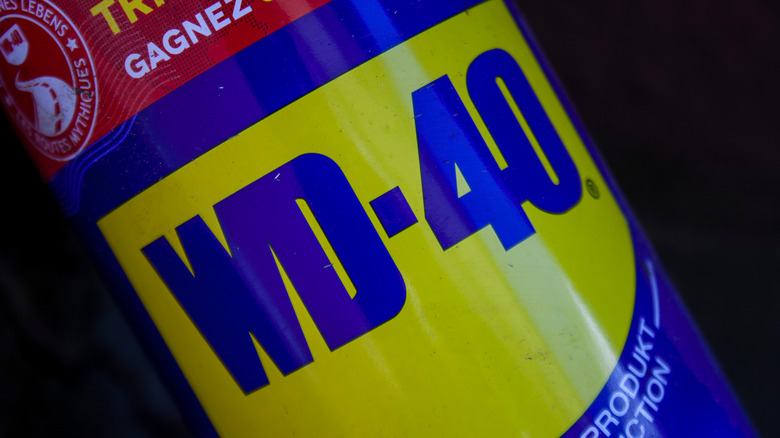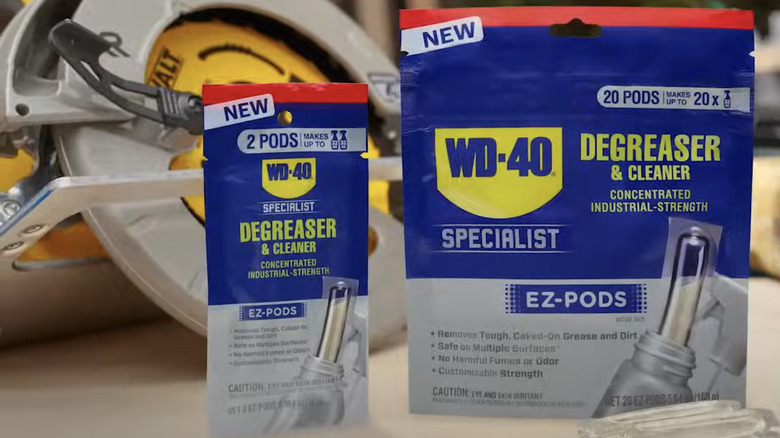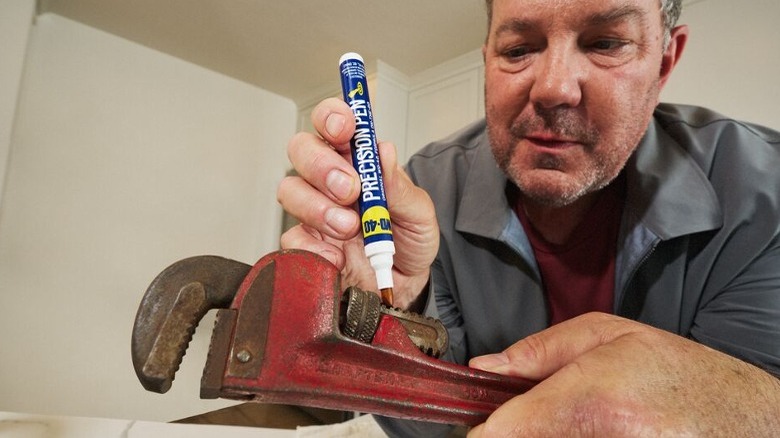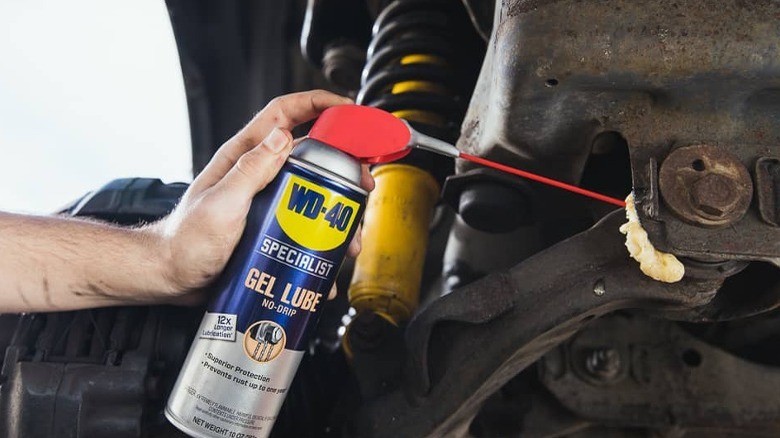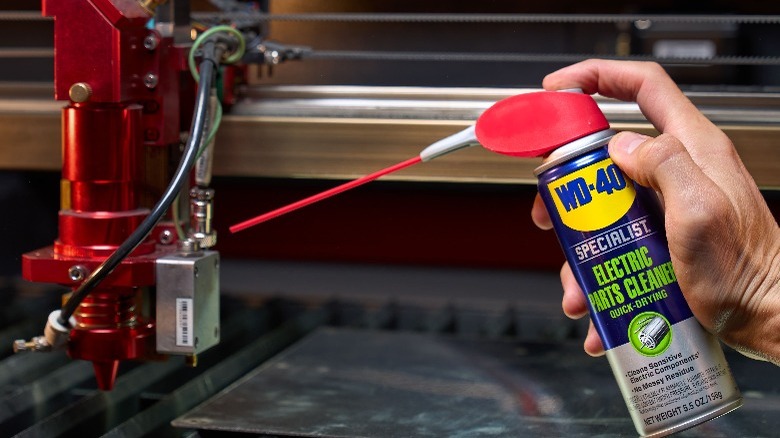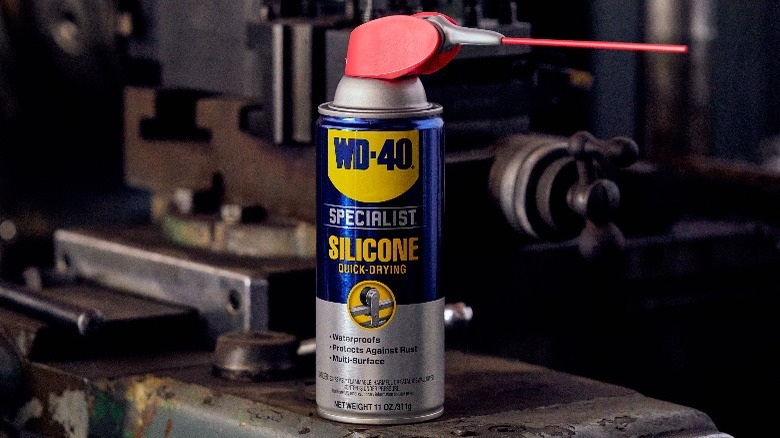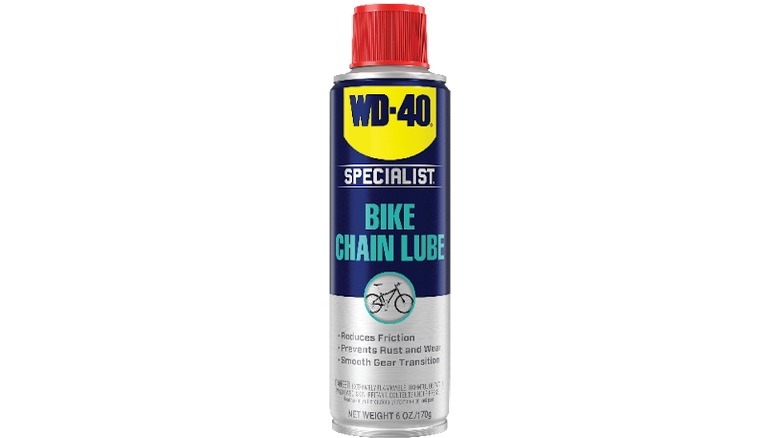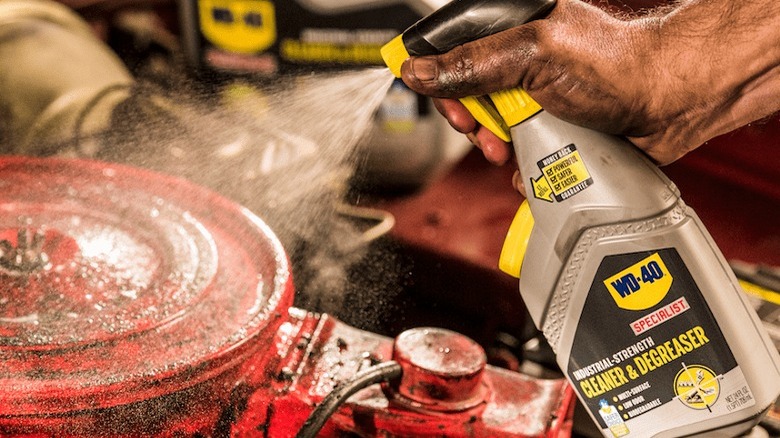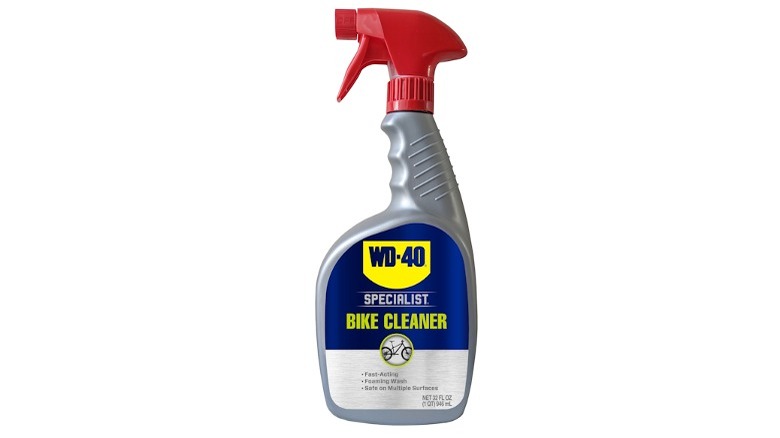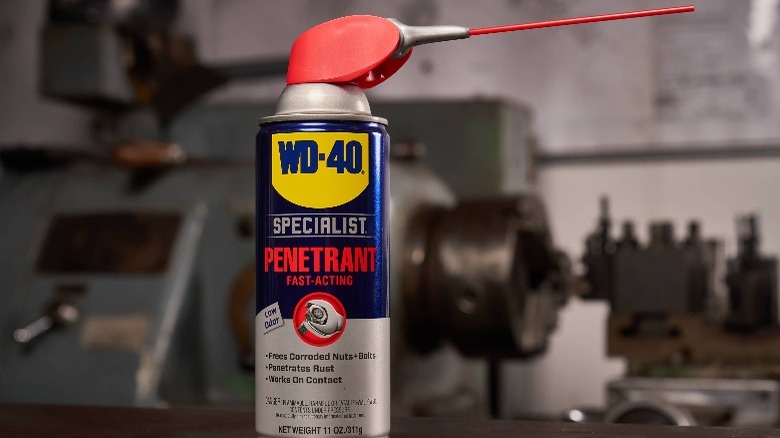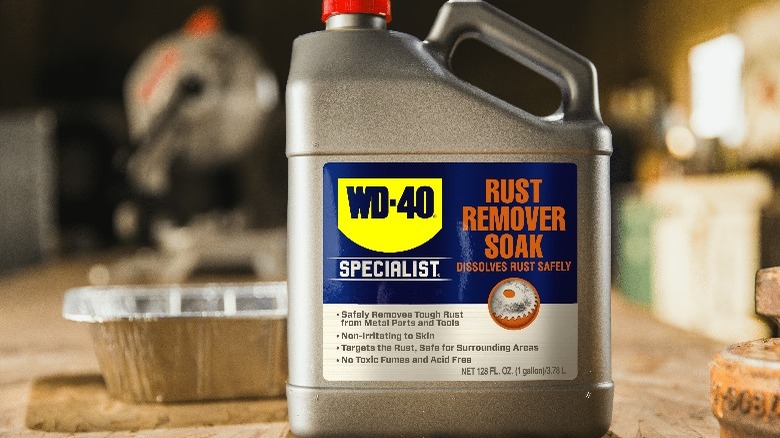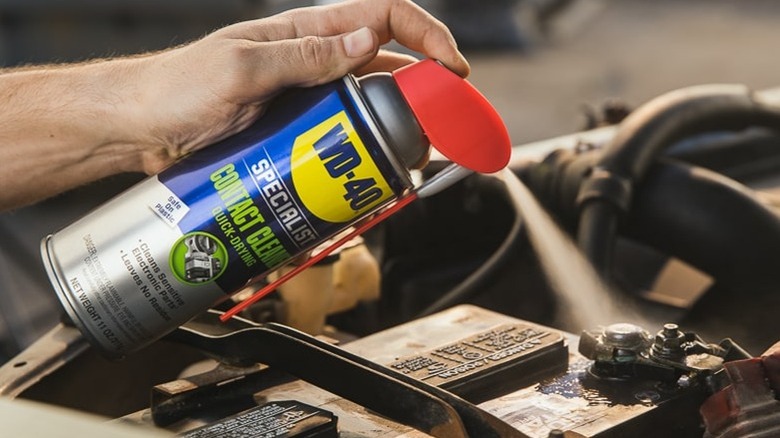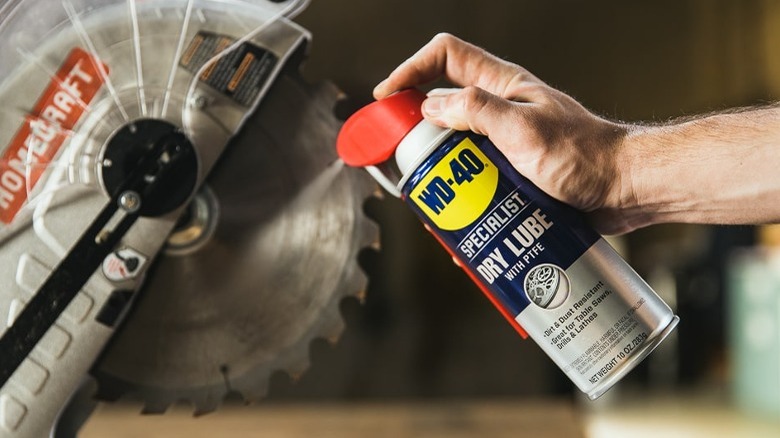12 Different WD-40 Products You Might Not Realize Exist
To most people, the name WD-40 is associated only with the lubricant and degreasing multi-use spray that is famous all over the world. However, not a lot of people know that WD-40 is actually the name of the entire brand, rather than a single product, and that brand has a lot more to offer than one multi-use spray.
The truth is that WD-40 sells sprays, cleaners, and specialist items that are designed to tackle all kinds of problems you might encounter at your home or in the workplace. WD-40 can do a lot, but it can't do everything, so one or more of the alternatives the company makes might be better suited to your particularly needs.
Here we are going to explore the WD-40 catalog out of the original spray and see some of the items the brand sells that you were probably completely unaware of and what they can do.
EZ-Pods
Among WD-40's most recent additions to its lineup are the WD-40 Specialist Degreaser & Cleaner EZ-Pods. These are essentially dissolvable containers that carry a concentrated solution designed to tackle grease and dirt on a variety of surfaces. The idea behind the pods is that they can be placed in a container of water — whether it be a spray bottle, power washer, or bucket — and diluted to the necessary strength for the job. The company claims that one pod in 32 ounces of water will be enough for most jobs, although two or more can be used for cases where thick grease and dirt has dried onto a surface.
What makes the EZ-Pods so appealing is that they are versatile. As a cleaner, they can be used in a variety of different spaces, ranging from home and commercial kitchens to factories and garages. Thanks to the fact that the liquid inside is both non-corrosive and non-abrasive, it is safe to use on eating surfaces as well as surfaces that might be damaged with other cleaners — including rubbers and plastics.
Once placed in the water, the pods should dissolve in a couple of minutes and then the solution can be sprayed or poured onto the surface that needs to be cleaned. The fact that pods are small and durable means they are perfect to be carried around without the need for large bottles.
Precision Pen
Despite its name, the WD-40 Precision Pen is not a pen in the ink and writing sense, but rather an instrument that is pen-shaped. The Precision Pen is simply a different delivery method for the company's signature lubricant. In this case, the device is intended to be used when the workspace is particularly small and confined, allowing users to operate in a tight space or only use enough WD-40 formula for the job at hand without risking getting it on other surfaces.
Described as versatile and portable by the company, the Precision Pen is around the same size and shape as a traditional pen. This makes it small enough to easily carry around on jobs or in the home, as it can fit in a pocket or tool box without any issues. The "easy-to-hold design" also helps users apply a controlled flow of WD-40 formula in a precise manner.
While it can be used on a variety of surfaces like standard WD-40, the Precision Pen is particularly useful for gears, threads, and hinges. The small size of the instrument also means it is a great choice if you want to lubricate moving parts of power tools or mechanical components such as hinges.
WD-40 Gel Lube
In many ways, the WD-40 Gel Lube is just an evolution of the WD-40 product most people are familiar with. Like the standard formula, it is a lubricant that can help keep moving parts moving and protects from rust and other forms of corrosion. The main difference being that it is a thick gel rather than the less viscous liquid normally used. The idea behind the gel is that it offers much longer protection, with WD-40 suggesting it can last for up to 15 times longer than its competitors and still work in temperatures ranging from -100 degrees to 500 degrees Fahrenheit.
One of the other main advantages of the Gel Lube is that its no drip design means that it won't spill off parts onto the surrounding area. Anyone who regularly needs to lubricate or degrease machinery in spaces that they'd prefer to keep clean, such as an auto shop, can rely on the gel rather than the WD-40 formula that will slowly drip onto the floor. Even on parts that move at speed, the gel should stay in place and not be flung off.
The official product page for WD-40 Gel Lube claims that it is particularly useful for farmers, who have equipment that spends a lot of time outdoors in cold conditions and has many moving parts, including chains and rollers.
WD-40 Electric Parts Cleaner
Although there are certainly some unexpected uses for WD-40, there are also a lot of devices and surfaces it shouldn't be used on. One of those is electrical components — the oil-based original WD-40 formula can damage external parts and the liquid can easily seep into cracks and crevices, potentially causing havoc with any internal components it touches.
However, electrical devices do sometimes need a bit of tender loving care as they can get just as dirty as mechanical devices. That's where WD-40 Electric Parts Cleaner comes in. This is a specialist product designed specifically to be used with electronic devices, with the company stating that it works well with everything from drones to 3D printers, with the cleaner also a good alternative for cleaning gaming controllers or connections on the end of cables.
The aim of WD-40 Electric Parts Cleaner is to remove surface contaminants in hard to reach areas without causing any harm. It is NSF Listed K2 safe so can be used in food production areas and also VOC compliant so you can be sure it won't emit any dangerous gases or material. Meanwhile, a smart straw that comes with the can allows users to switch between a precision application or a wider spray.
WD-40 Silicone
Another product from the WD-40 company that you may well find useful is WD-40 Silicone. It uses a different formula to effectively carry out the same function as the original product. It utilizes a low vapor pressure petroleum solvent alongside a silicone polymer and a propellant made of propane and n-butane. If you are wondering what the differences are between WD-40 Silicone and the multi-use formula then you just need to look how the products are intended to be used.
Where WD-40 Silicone excels is as a long-term water-resistant lubricant, making it the number one choice for use in outdoor spaces. It can provide lubrication to a wide array of surfaces, including metals and vinyl, and dries quickly to leave a thin layer of clear silicone. It can also provide a level of protection against dirt and wear, helping to prolong the life of moving parts.
WD-40 indicates that this silicone lubricant can protect and lubricate moving parts for more than twice as long at competing products while also abiding by safety standards. This makes it a good choice for chains, pulleys, belts, and other high-speed moving parts, as well as plumbing components such as pipes and washers thanks to its water resistance.
WD-40 Bike Chain Lube
WD-40 is often a go-to choice for those looking to quickly lubricate or clean their bicycle chains in a pinch. Yet, it is far from the best option in this regard. While it can do a good job of cleaning the chain and helping get rid of any grease, it's not a great lubricator. That's even more true when you consider that bicycles will often get wet through rain or standing water.
If you want to stick with a trusted brand like WD-40 but really get your bicycle chain in top working condition, then WD-40 Bike Chain Lube is what you need. A specialist bike chain lube, it has been developed to work in all conditions, so it doesn't matter when you are cycling in dry and hot conditions or during heavy rain, the lube will keep your chain running smoothly while protecting it from the elements.
WD-40 Bike Chain Lube is long lasting, so you won't have to lube your bike chain often, and it doesn't contain any wax. This ensures that no residue will build up on the chain to affect its performance. There's also corrosion inhibitors to stop the chain from becoming damaged or rusting.
WD-40 Cleaner & Degreaser
While WD-40 is excellent for cleaning surfaces that have caked-on grease and dirt, it isn't exactly something that you'd want to spray on every single surface. The oil-based nature of the multi-use formula and its lubricating properties make it less than ideal when it comes to most everyday work surfaces and items. After all, if something doesn't have any moving parts, standard WD-40 is unlikely to be the best solution for cleaning it.
But that doesn't mean that the brand doesn't have you covered. As part of its range, it offers the specialist WD-40 Cleaner & Degreaser. This is more of a general cleaning product, which doesn't spray out of the container with any aerosols. WD-40 Cleaner & Degreaser also uses a bio-solvent formula, which allows it to be used on a wider variety of surfaces even if they are sensitive or being used for food preparation.
Some of the uses that the brand proposes for this product include cleaning auto shops, tools, and vehicles, with the cleaner able to be applied to all surfaces. The non-flammable formula also means it is safe to use in areas that get hot. For those who need a commercial supply, WD-40 Cleaner & Degreaser can be purchased in a variety of different sizes, from a 24 ounce bottle to a 55 gallon drum.
WD-40 Bike Cleaner
Not content with providing a specific cleaner and lubricant for bicycle chains, the WD-40 brand has also launched a dedicated product for cleaning bicycles. Unlike its cousin, WD-40 Bike Cleaner is designed for use on the entire bicycle, not just the chain or other moving parts. That's why it comes in a more traditional spray bottle rather than an aerosol dispenser, releasing a foaming agent that washes rather than providing any lubrication or protection.
According to WD-40, the WD-40 Bike Cleaner is a biodegradable foaming wash that can be used on every surface of a bicycle, from the metal frame to the rubber tires and plastic components. It doesn't matter whether your particular model is made of carbon fiber or steel, the cleaning agent should work on all of them without issue, removing even tough grease and dirt from surfaces.
Before using the product, it is recommended that loose debris is rinsed off with a horse, before spraying the bike with the foam. After a few minutes, it can then be scrubbed with a sponge or brush before being dried with a towel for the perfect finish. The company has confirmed that its bicycle cleaning has gone through "extensive testing at the hands of internal and third party scientists, bicycle retailers, and professional mechanics," so customers can be sure that it performs at a high level.
WD-40 Rust Penetrant
As well as being a lubricant and cleaner, WD-40 can also help not only get rid of rust but also protect surfaces from future corrosion. However, the standard multi-use version of WD-40 is only really suitable for surface rust, when the corrosion has not penetrated deep into machinery or caused parts to fully seize. In these instances, a different product like WD-40 Rust Penetrant that can fully break down rust is needed.
WD-40 Rust Penetrant works by flowing into narrow spaces through capillary action, allowing it to penetrate deep into parts where any rust may have formed. After a couple of minutes, the solution should have broken down the bonds enough to loosen parts that were previously stuck together. This can include a range of items, such as bolts, nuts, chains, and even locks.
This product also comes with a WD-40 innovation in the form of the EZ-Reach. This is a proprietary flexible straw that can be bent in any direction and then will hold its shape. At 8 inches long, it can fit into many hard to reach places and allow users to get the rust penetrant exactly where it is needed while staying in a comfortable position. It can even help keep businesses efficient by allowing jobs to be completed in less time as even tight and confined spaces shouldn't pose an issue.
WD-40 Corrosion Inhibitor
A major problem for metal parts of any kind is corrosion. This chemical reaction happens when metals react with gases and liquids that can damage the structure of the material. Ultimately, corrosion can significantly weaken metal parts, cause them to seize and fix in place, or become prone to leaking. All of these problems are best avoided, and when it comes to corrosion such as rusting, preventative action is always better than reacting to problems once they have set in.
With a product like WD-40 Corrosion Inhibitor, corrosion can be delayed and even avoided. Designed to extend the life of tools and keep equipment running efficiently, it is made up of a spray that coats the surface of its target and provides a protective layer that can remain steadfastly in place for an extended period of time. WD-40 claims that it can last up to 40 times as long as similar products from other brands and can keep metal items rust free for up to two years in an indoor setting and an entire year in outdoor conditions.
Thanks to the fact that it lasts so long, WD-40 Corrosion Inhibitor is useful for equipment and tools that are in storage and not being used regularly, keeping them safe from rust without regular cleaning or use. It can even work in high humidity, where the risk of rust from high water levels in the air is far more likely.
WD-40 Contact Cleaner
WD-40 Contact Cleaner is a specialist product developed by the brand for use on electrical contacts and sensitive parts — anywhere regular multi-use WD-40 could interfere with electrical signals being received properly. The lack of any harmful substances in the ingredients means it can be used on all kinds of electrical equipment, from circuit boards and battery terminals to guitar amps and power tools. The contact cleaner simply needs to be sprayed at the target using the included precision smart straw, which is intended to blow away a variety of contaminants such as grease, dust, silicone, and flux paste. Basically, the electrical parts cleaner spray we mentioned earlier is for the exterior of a device or component, and this is safe for the interior.
The quick drying nature of WD-40 Contact Cleaner also ensures that equipment can be used almost immediately, and the product won't leave any residue behind that might attract grime and dirt. The company also confirms that it can be used in the home or in busier environments such as in industrial settings.
WD-40 Dry Lube
Most lubricants come in a liquid form, with the oil coating the target surface to provide a layer of lubrication. However, there are circumstances when using a dry lube rather than a wet lube can be beneficial. Take for instance environments where oxidization is likely or in very dry and hot conditions. These types of situations are better suited to dry lube like WD-40 Dry Lube.
One of the most common mistakes people make when using WD-40 is to use it on door hinges and other similar areas. This is because the oil-based liquid can attract dirt and debris that might affect the lifespan and usefulness of the mechanism. WD-40 Dry Lube avoids this problem as it doesn't attract residue. This product uses PTFE (polytetrafluoroethylene), a chemical substance that is hydrophobic and non-stick, to ensure it doesn't collect any grease and grime.
According to the product page for WD-40 Dry Lube, the lubricant will stay effective in conditions as cold as -50 degrees up to highs of 500 degrees Fahrenheit. The quick drying layer will also help protect against corrosion and rusting, making it especially useful for bringing old power tools safely back to life or in areas where cleanliness is particularly important, as less clean-up will be required after using it.
